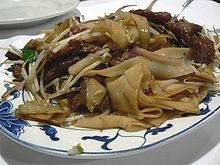- Shahe fen
-
Shahe fen 
A thinner version of Shahe fen Chinese 沙河粉 Transcriptions Hakka - Romanization sa ho fun Mandarin - Hanyu Pinyin shā hé fěn Cantonese (Yue) - Jyutping saa1 ho4 fan2 hefen Chinese 河粉 Transcriptions Hakka - Romanization ho fun Mandarin - Hanyu Pinyin hé fěn Cantonese (Yue) - Jyutping ho4 fan2 Shahe fen or he fen is a type of wide Chinese noodle made from rice.
Contents
Names
While shahe fen and he fen are transliterations based on Mandarin, there are numerous other transliterations based on Cantonese, which include ho fen, hofen, ho-fen, ho fun, ho-fun, hofoen (a Dutch transliteration in Suriname), hor fun, hor fen, sar hor fun, etc. In addition, shahe fen is often synonymously called kway teow (粿條), literally "ricecake strips", transliteration based on Min Nan Chinese, POJ: kóe-tiâu) or guotiao (pinyin: guǒtiáo; the corresponding transliteration of Mandarin), as in the name of a dish called char kway teow. However, shahe fen and kway teow are strictly and technically not the same (the latter being essentially ricecakes sliced into strips) and the Min Nans in general still consciously make a distinction between shahe fen and kway teow in their speech. Original ricecakes or its strips are very stiff in texture (even after cooking), making them unpopular with modern consumers.
It is also known in Sabah as da fen (大粉), means "wide vermicelli", due to its similarity of colour and texture to vermicelli.
These noodles are called sen yai (Thai: เส้นใหญ่, meaning "large rice noodles") in Thailand, and kwetiau in Indonesia.
Origin
Shahe fen is believed to have originated in the town of Shahe (沙河; Cantonese: Sa1ho4 pinyin: Shāhé), now part of the Tianhe District in the city of Guangzhou, in the southern Chinese province of Guangdong, whence their name derives. Shahe fen is typical of southern Chinese cuisine, although similar noodles are also prepared and enjoyed in nearby Southeast Asian nations such as Vietnam, Thailand, Cambodia, Philippines, Malaysia, Indonesia and Singapore, all of which have sizeable Chinese populations.
Types
Shahe fen noodles are white in color, broad, and somewhat slippery. Their texture is elastic and a bit chewy. They do not freeze or dry well and are thus generally (where available) purchased fresh, in strips or sheets that may be cut to the desired width. Where fresh noodles are not available, they may also be purchased packaged in dried form, in various widths.
Shahe fen noodles are very similar to Vietnamese bánh phở noodles, which are likely derived from their Chinese counterpart. Although the phở noodles used in soups may vary in width, wide phở noodles are also common in stir fried dishes. The popular Thai dishes pad see ew and drunken noodles are also made with similar noodles.
Chao fen
Shahe fen is often stir fried with meat and vegetables in a dish called chao fen (炒粉; pinyin: chǎo fěn). While chao fen is a transliteration of Mandarin, chow fun from Cantonese is the name to which this dish is most often referred in Chinese restaurants in North America.
See also
Cantonese cuisine Main dishes Bao yu • Beef chow fun • Bird's nest soup • Buddha's delight • Cantonese seafood soup • Chinese steamed eggs • Congee • Crispy fried chicken • Dragon tiger phoenix • Hot pot • Seafood birdsnest • Shark fin soup • Snake bite chicken • Soy sauce chicken • Subgum • Sweet and sour pork • White boiled shrimp • White cut chicken • Wonton noodle • Yeung Chow fried riceDim sum / Yum cha Almond jelly • Cha siu baau • Chicken feet • Coconut bar • Egg tart • Har gow • Jau gok • Jiaozi • Jin deui • Lo mai gai • Mango pudding • Nian gao • Nuomici • Ox-tongue pastry • Rice noodle roll • Shaomai • Spring roll • Steamed meatball • Swiss Wing • Taro cake • Taro dumpling • Tendon (meal) • Tofu skin roll • Turnip cake • Water chestnut cake • You tiao • ZhaliangSiu laap Char siu • Chinese sausage • Lou mei • Orange cuttlefish • Roast goose • Siu mei • Siu yuk • White cut chickenDesserts / Pastry Almond biscuit • Beef bun • Biscuit roll • Cocktail bun • Cream bun • Curry beef triangle • Deuk Deuk Tong • Douhua • Eggette • Ginger milk curd • Ham and egg bun • Mooncake • Paper wrapped cake • Peanut butter bun • Pineapple bun • Red bean soup • Sausage bun • Tong sui • White sugar sponge cakeCondiments / Spices Ingredients Beef ball • Black bean paste • Chenpi • Fermented black beans • Fish ball • Fish slice • Frog legs • Garland chrysanthemum • Kai-lan • Mantis shrimp • Pig's ear (food) • Prawn ball • Rapeseed • Saang mein • Sea cucumber (food) • Shahe fen • Shrimp roe noodles • Spare ribs • Suan cai • Tofu skin • Wonton • Yi mein • Zha caiOthers Chinese noodles Ants climbing a tree • Ban mian • Beef chow fun • Beef noodle soup • Biángbiáng noodles • Cart noodle • Cellophane noodles • Champon • Char kway teow • Chow mein • Cu mian • Crossing the bridge noodles • Dan dan noodles • Henan braised noodles • Hokkien mee • Jook-sing noodles • Ka tieu • Lamian • Lai fun • Liang pi • Lo mein • Mee pok • Mi xian • Millinge • Misua • Mung bean sheets • Oil noodles • Re gan mian • Rice noodles • Rice vermicelli • Saang mein • Satay bee hoon • Shahe fen • Shanghai fried noodles • Shrimp roe noodles • Silver needle noodles • Wonton noodles • Yi mein • You mian • Zha jiang mian
Wikimedia Foundation. 2010.



